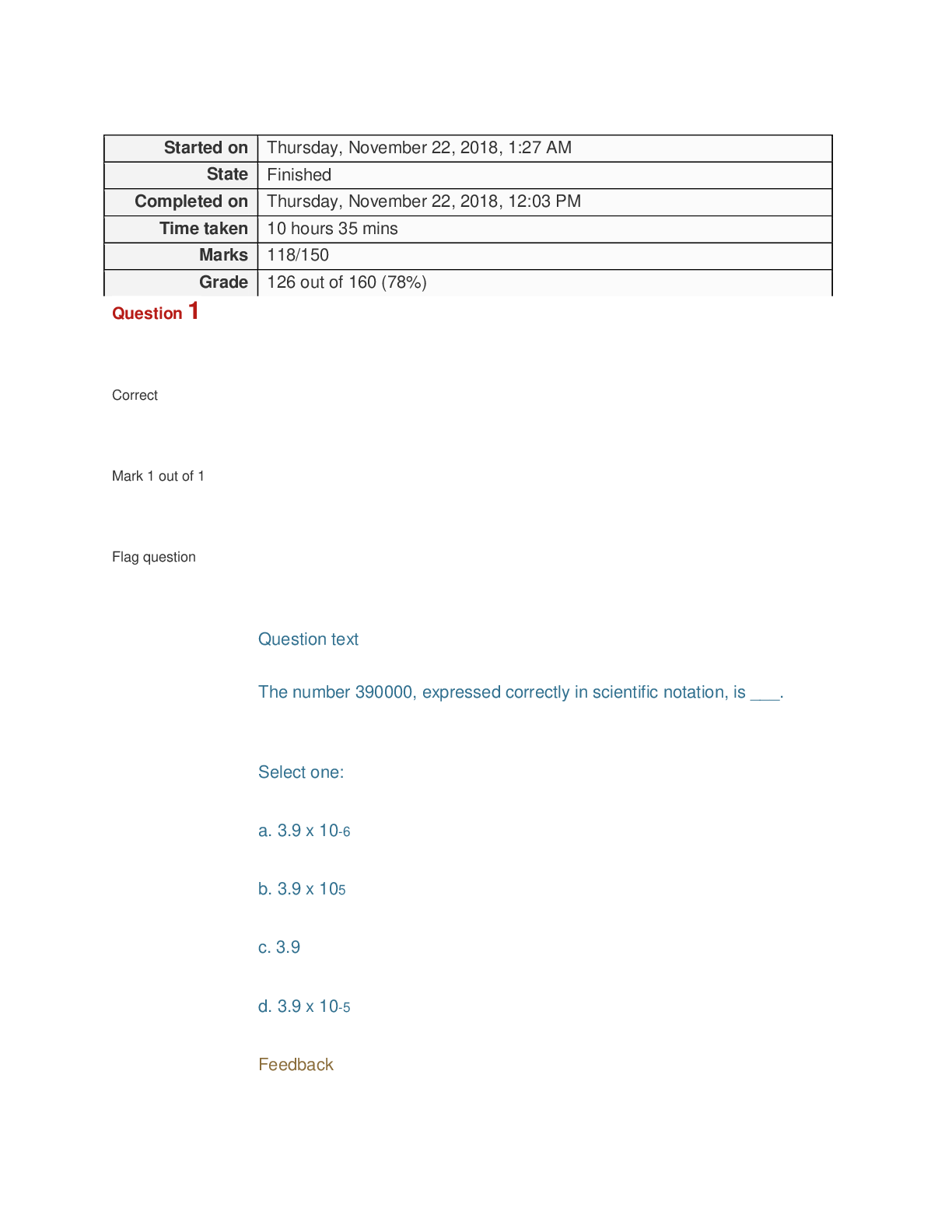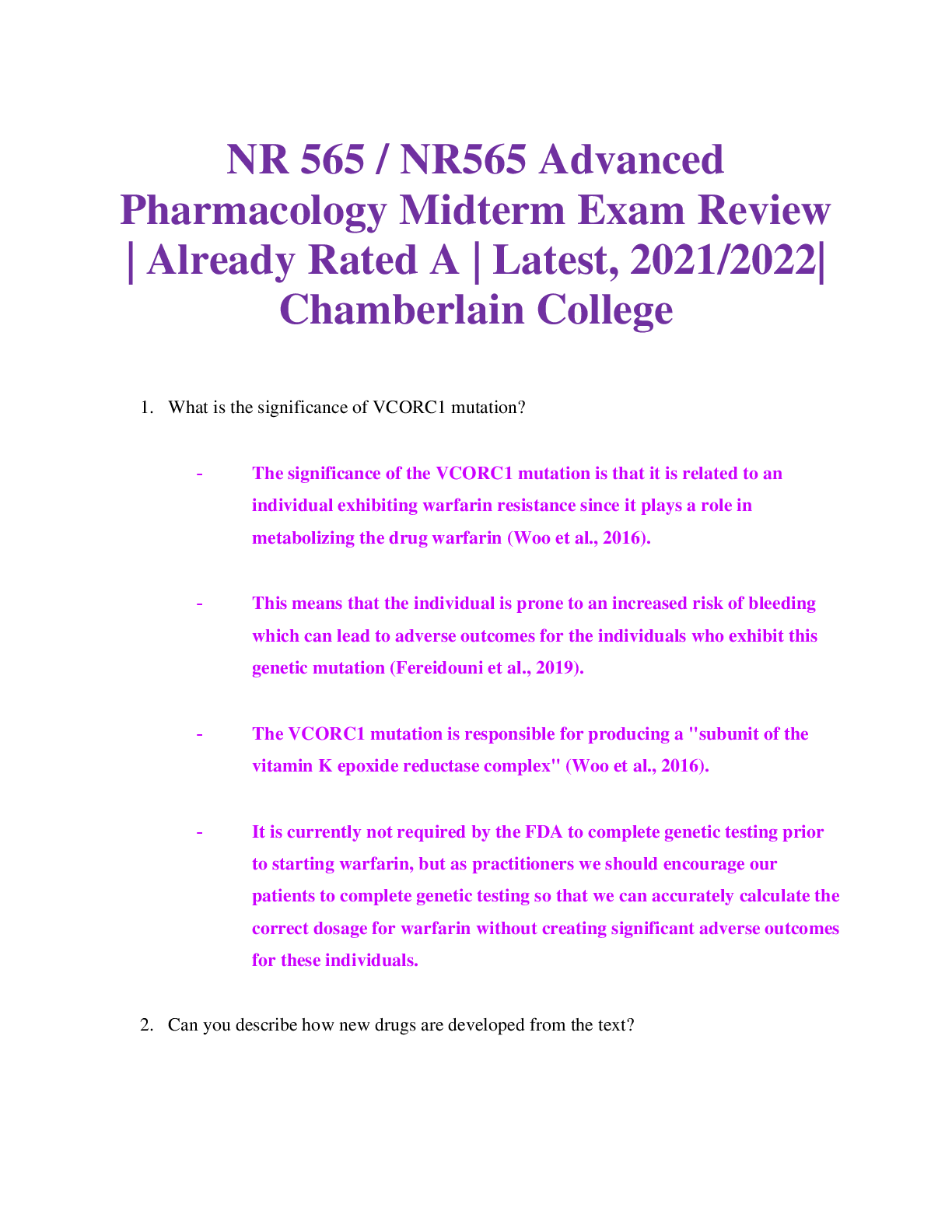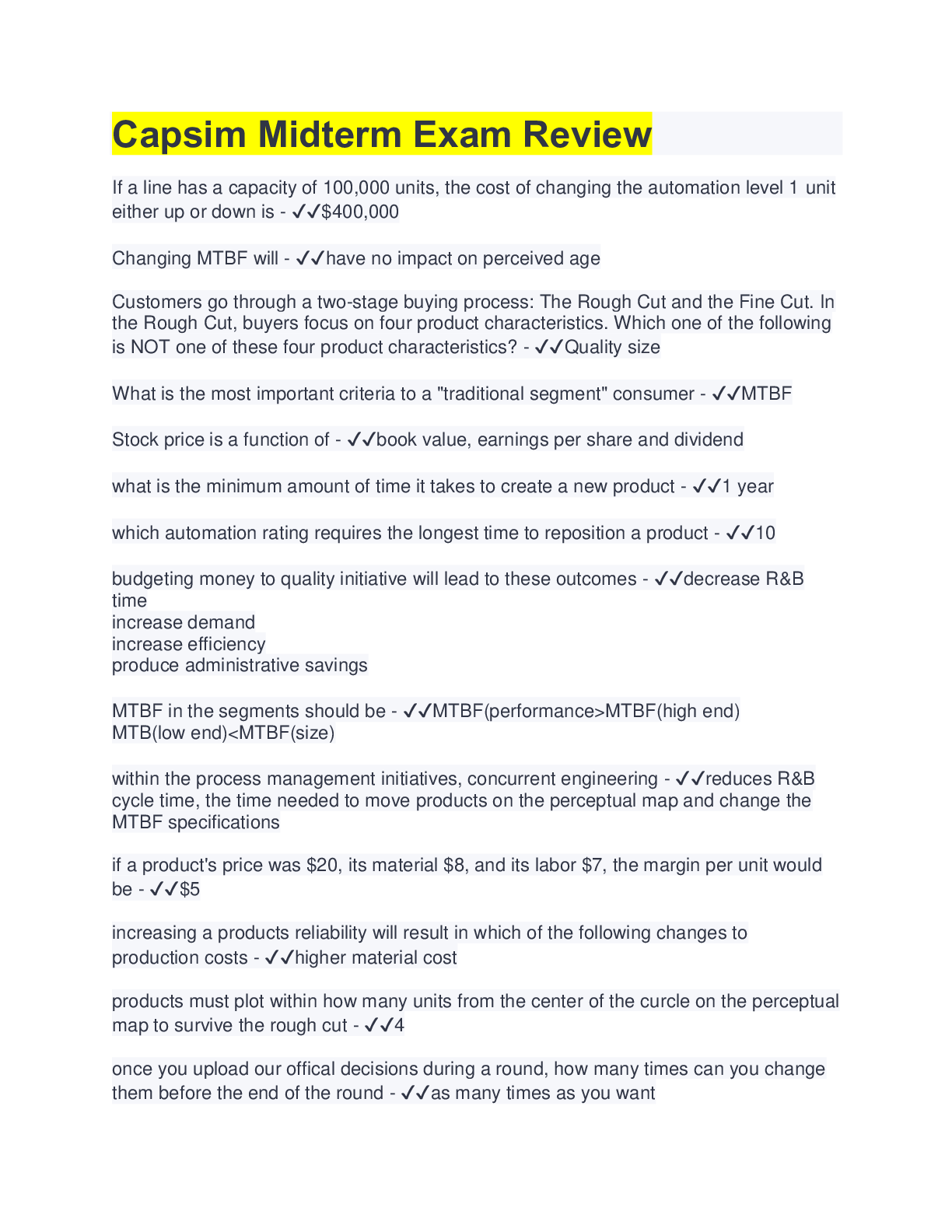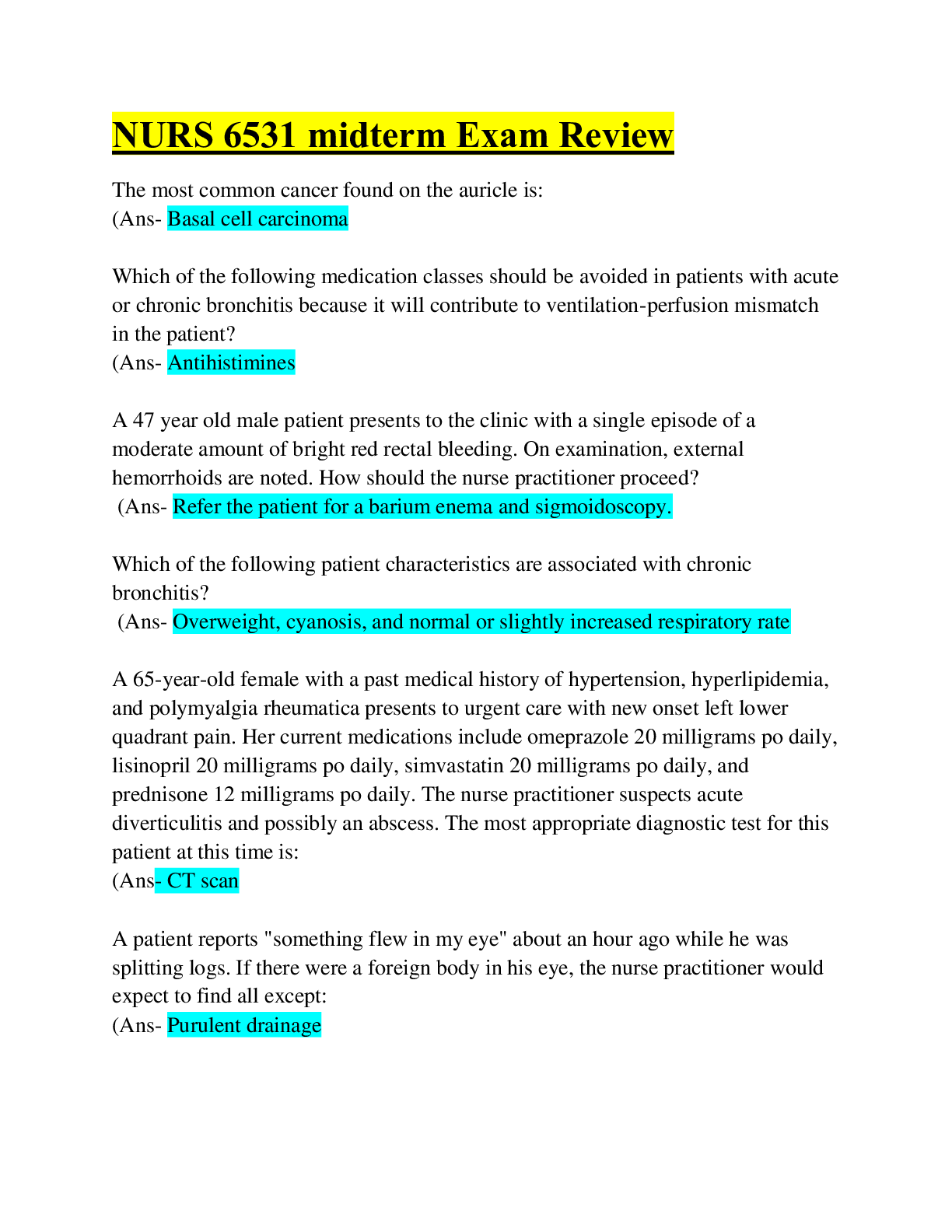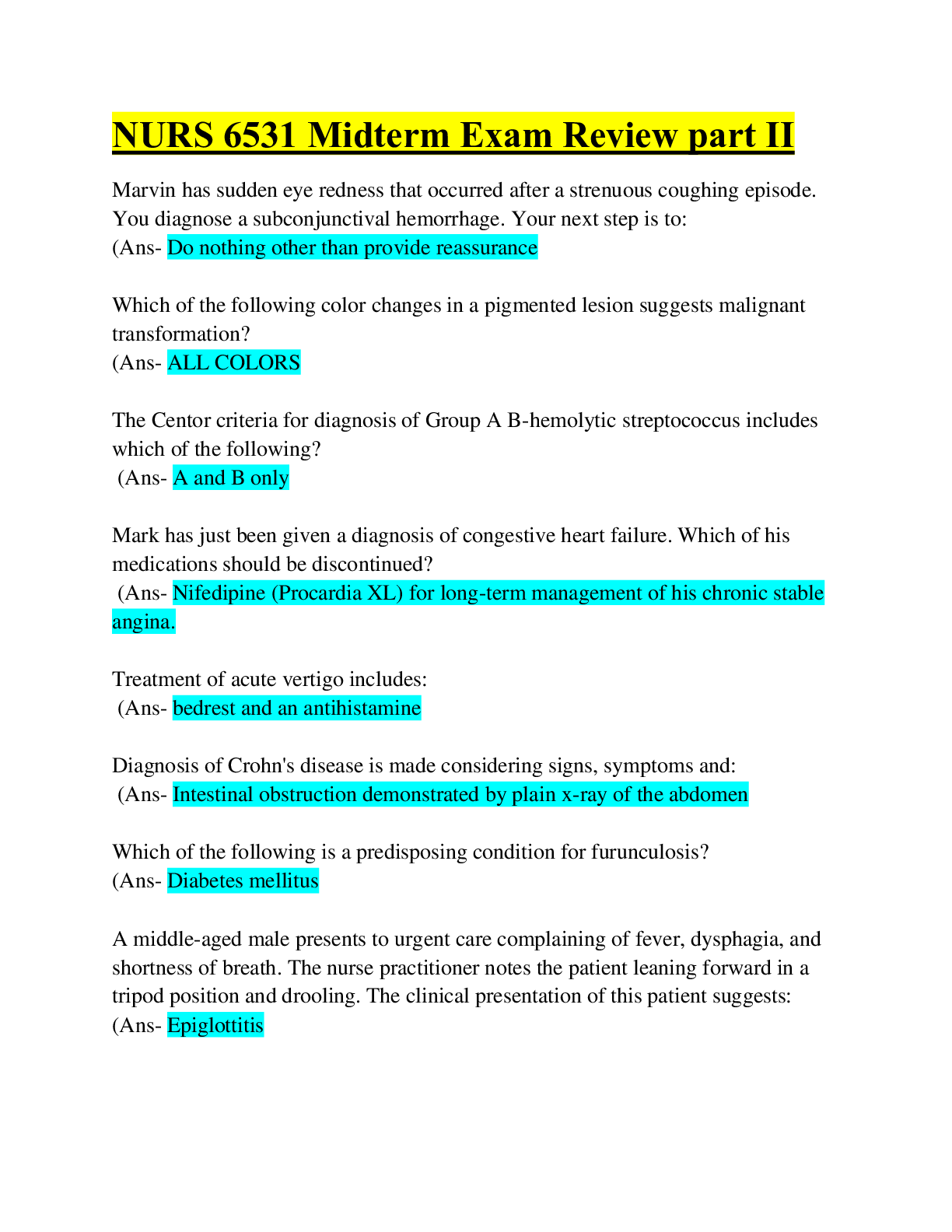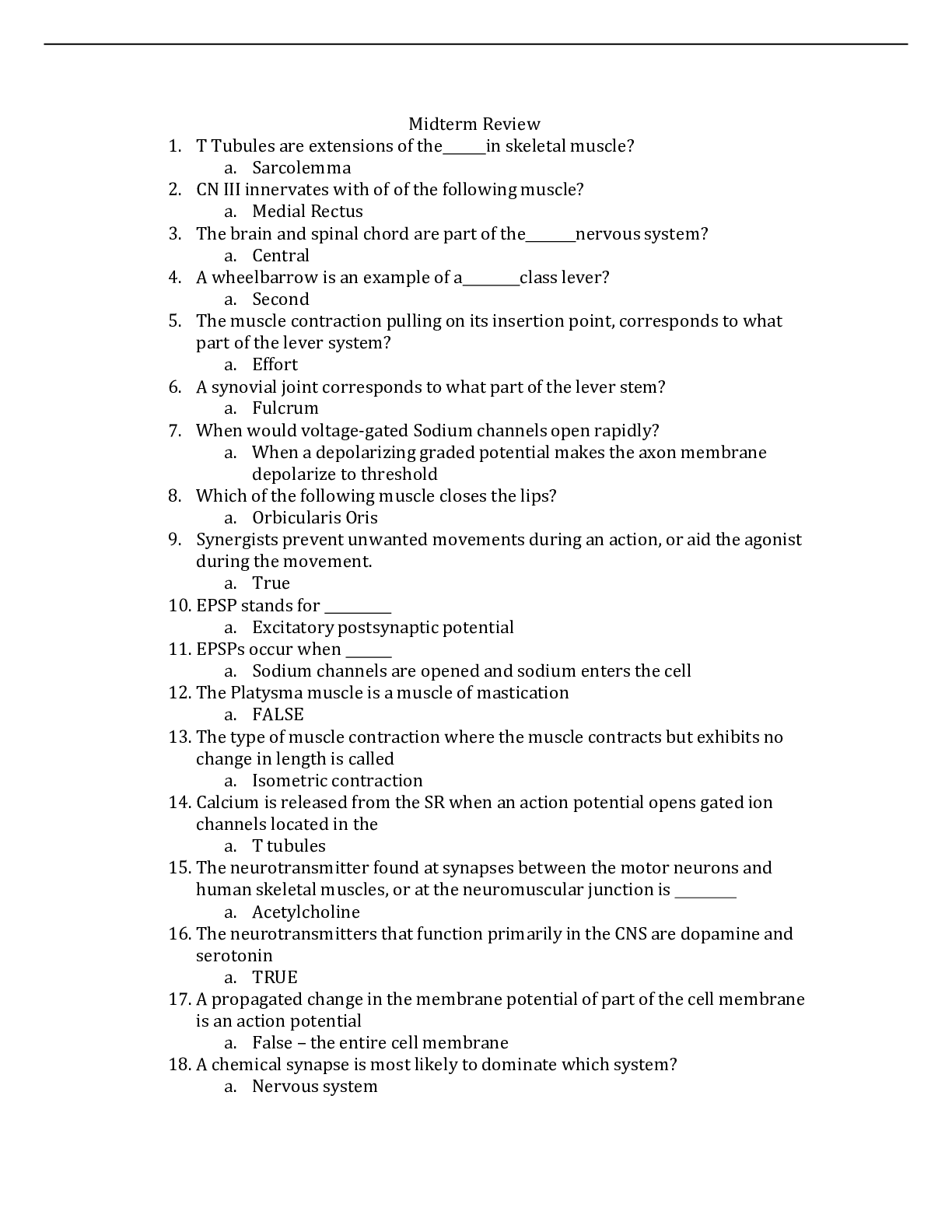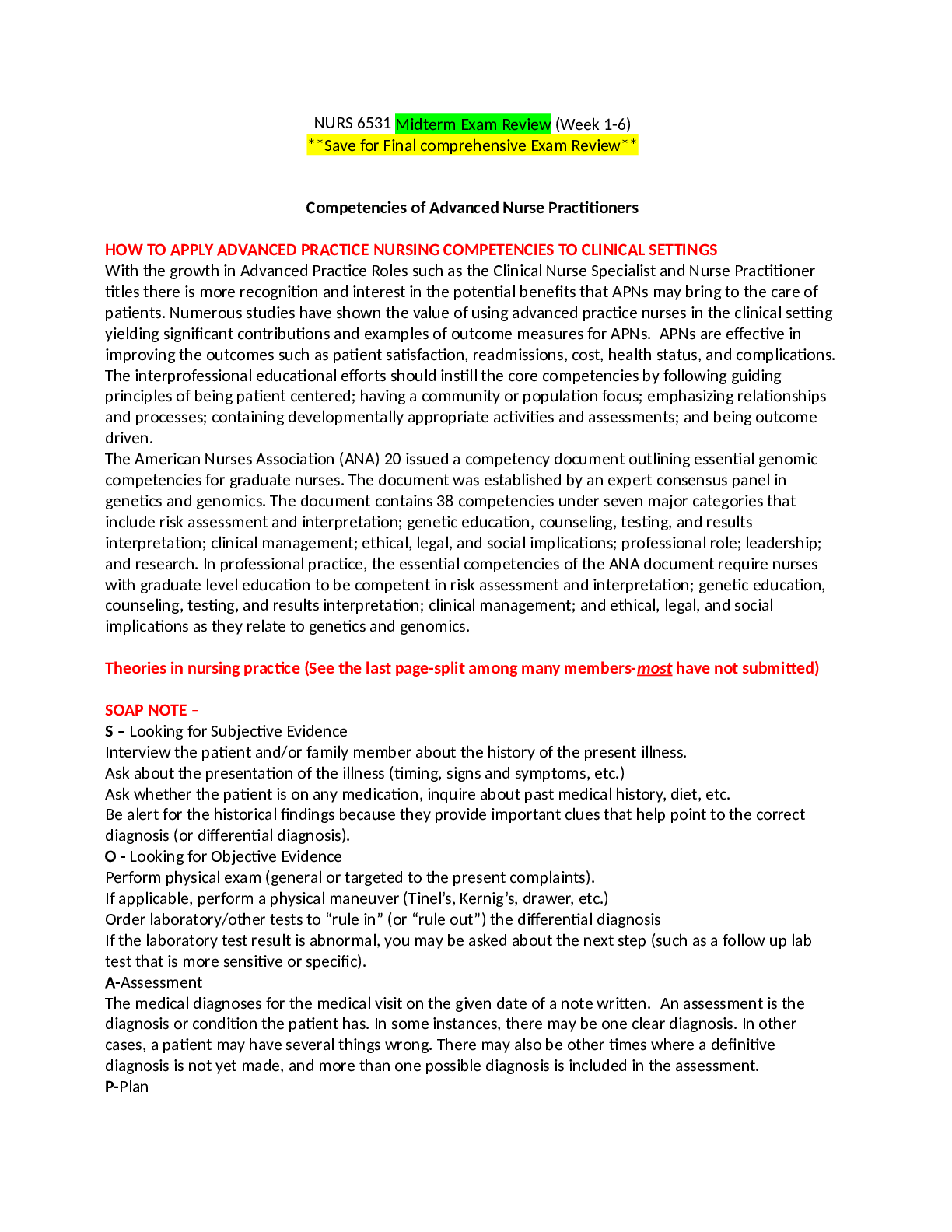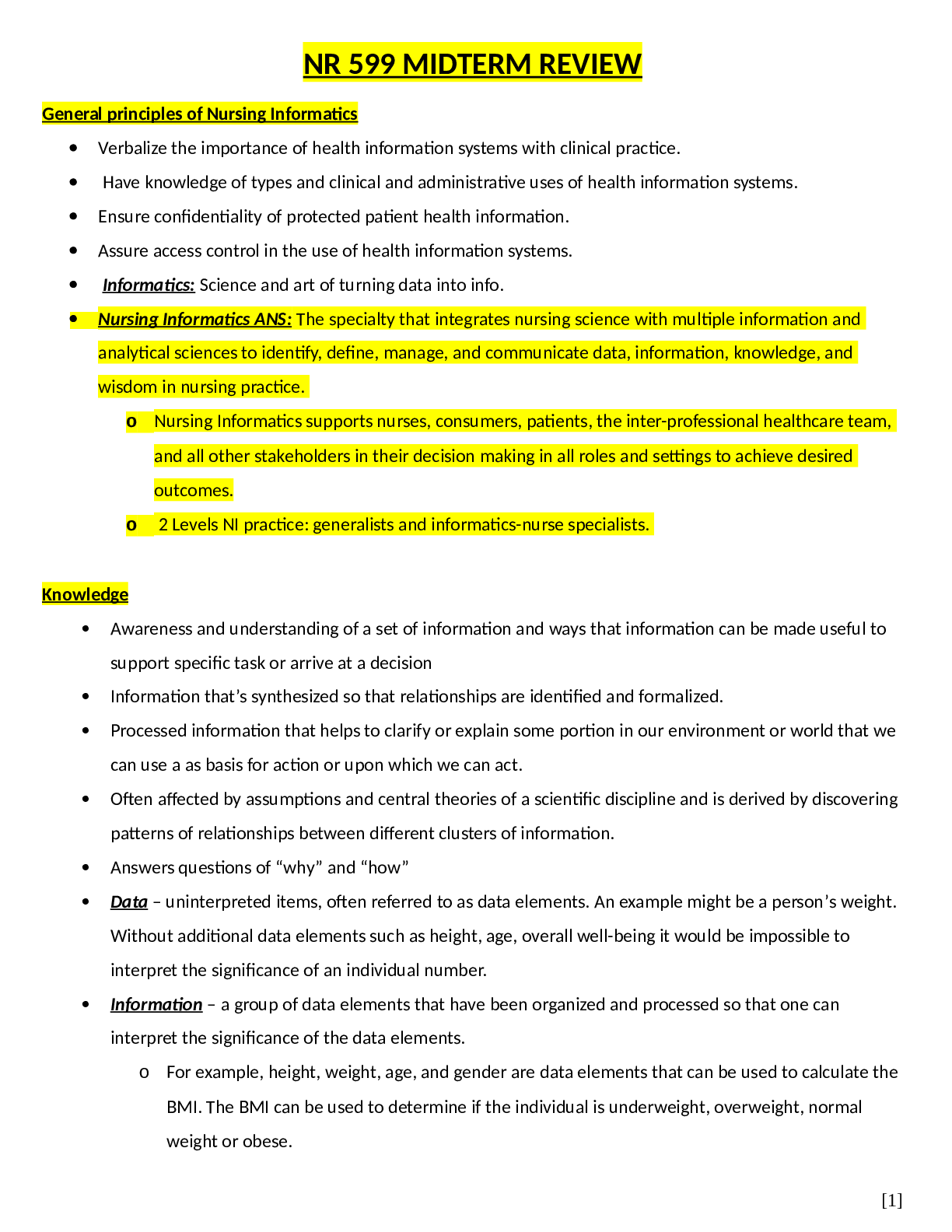*NURSING > EXAM REVIEW > Nurs 6501 Midterm Exam Review Guide (Weeks 1-6). 1. Describe cellular processes and alterations with (All)
Nurs 6501 Midterm Exam Review Guide (Weeks 1-6). 1. Describe cellular processes and alterations within cellular processes. 2. What is the impact of the genetic environment on disease? 3. Explain how healthy cell activity contributes to good health and how its breakdown in cellular behavior and alterations to cells lead to health issues. 4. What are the roles genetics plays in disease processes? See answer for question 2. 5. What is the relationship of how cells are involved in disease processes? Altered Physiology 6. Evaluate cellular processes and alterations within cellular processes. 7. Analyze alterations in the immune system that result in disease processes.This Document contains 99 Pages Of exam reviw materials for quick study Covering the whole 6 weeks. Has explained questions and Answers. See the description below for details.
Document Content and Description Below
Nurs 6501 Midterm Exam Review Guide (Weeks 1-6) Cellular Processes and the Genetic Environment 1. Describe cellular processes and alterations within cellular processes. 2. What is the impact of t he g... enetic environment on disease? 3. Explain how healthy cell activity contributes to good health and how its breakdown in cellular behavior and alterations to cells lead to health issues. 4. What are the roles genetics plays in disease processes? See answer for question 2. 5. What is the relationship of how cells are involved in disease processes? Altered Physiology 6. Evaluate cellular processes and alterations within cellular processes. 7. Analyze alterations in the immune system that result in disease processes. Type II (tissue-specific) hypersensitivity reactions are caused by five possible mechanisms: Type III (immune complex–mediated) hypersensitivity reactions are caused by the formation of Type IV (cell-mediated) hypersensitivity reactions are caused by either cytotoxic T lymphocytes SLE is a chronic, multisystem, inflammatory disease and is one of the most serious of the Hyperacute graft rejection (preexisting antibody) is immediate and rare, acute rejection is cell 8. Identify racial/ethnic variables that may impact physiological functioning. Will list these with individual disease processes. 9. What is the impact of patient characteristics on disorders and altered physiology? Will list with individual disease processes. 10. What is the association of genes in the development of disease? Genetic diseases caused by single genes usually follow autosomal dominant, autosomal recessive, or X-linked recessive modes of inheritance. Pedigree charts are an important tool in the analysis of modes of inheritance. 11. What is the process of immunosuppression and the effect it has on body systems? Disorders resulting from immune deficiency are the clinical sequelae (results) of impaired Concepts and Alterations of Cardiovascular and Respiratory Disorders 12. Common diseases and disorders that impact the Cardiovascular system, racial/ethnic variables, and patient characteristics. Varicose vein: refers to a condition in which venous blood has pooled, producing distortion of the veins, leakage, increased intravascular hydrostatic pressure, and inflammation (Fig. 33.1). DVT: Venous thromboembolism (VTE) includes deep venous thrombosis (DVT) and pulmonary embolism (PE). Superior vena cava syndrome (SVCS): is a clinical manifestation of progressive compression of the superior vena cava (SVC) that leads to venous distention in the upper extremities and head. Hypertension (HTN): is consistent elevation of systemic arterial blood pressure. Hypertension was defined in 2014 as a sustained systolic blood pressure Orthostatic (postural) hypotension (OH): refers to a decrease in systolic blood pressure of at least 20 mmHg or a decrease in diastolic blood pressure of at least 10 mmHg within 3 minutes of Aneurysm: is a localized dilation or outpouching of a vessel wall or cardiac chamber. Laplace's law can provide an understanding of the hemodynamics of an aneurysm. True aneurysms involve Thromboangiitis obliterans (Buerger disease): is an idiopathic autoimmune condition strongly Raynaud phenomenon and Raynaud disease: are characterized by attacks of vasospasm in the small arteries and arterioles of the fingers and, less commonly, the toes. Although the clinical Atherosclerosis: is a form of arteriosclerosis in which thickening and hardening of the vessel are caused by the accumulation of lipid-laden macrophages within the arterial wall, which leads to Peripheral artery disease (PAD): refers to atherosclerotic disease of arteries that perfuses the limbs, especially the lower extremities. PAD affects 10% to 15% of those who are 60 years of age or older, and is associated with significant morbidity and mortality. Coronary Artery Disease: The lowest prevalence among Asian Americans and the highest among native Hawaiians or other Pacific Islanders. NonHispanic whites and blacks have approximately Transient Myocardial Ischemia: CAD can diminish the myocardial blood supply causing ischemia. Stable Angina: Angina pectoris is chest pain caused by myocardial ischemia. Stable angina is caused by gradual luminal narrowing and hardening of the arterial walls, so that affected vessels Prinzmetal Angina: Prinzmetal angina (also called variant angina) is chest pain attributable to Silent Ischemia and Mental Stress (Induced Ischemia): Myocardial ischemia does not always cause angina and may be associated only with nonspecific symptoms such as fatigue, dyspnea, or feeling of unease. Acute Coronary Syndromes: When there is sudden coronary obstruction caused by thrombus Unstable angina: is a form of acute coronary syndrome that results in reversible myocardial ischemia. Myocardial Infarction: When coronary blood flow is interrupted for an extended period, myocyte necrosis occurs.. Acute pericarditis: is acute inflammation of the pericardium. The etiology of acute pericarditis is most often idiopathic (autoimmune) or caused by viral infection. Pericardial effusion: the accumulation of fluid in the pericardial cavity, can occur in all forms of pericarditis. Constrictive pericarditis, or restrictive pericarditis (chronic pericarditis): was once synonymous with tuberculosis. Dilated cardiomyopathy: is usually the result of ischemic heart disease, valvular disease, Hypertrophic cardiomyopathy: refers to two major categories of thickening of the myocardium: (1) hypertrophic obstructive cardiomyopathy (asymmetrical septal hypertrophic cardiomyopathy Restrictive cardiomyopathy: is characterized by restrictive filling and reduced diastolic volume Aortic stenosis (AS) is the most common valvular abnormality, affecting approximately 5% of adults older than 75 years. Mitral stenosis: impairs the flow of blood from the left atrium to the left ventricle. Mitral stenosis is the most common form of rheumatic heart disease (see the Acute Rheumatic Fever and Aortic Regurgitation: Aortic regurgitation results from an inability of the aortic valve leaflets to close properly during ventricular diastole, Mitral regurgitation: occurs in approximately 1.7% of the U.S. population. It can be primary because of mitral valve prolapse, rheumatic heart disease, infective endocarditis, MI, connective Tricuspid regurgitation: is more common than tricuspid stenosis and usually is associated with Mitral valve prolapse syndrome: is a condition in which the anterior and posterior cusps of the Rheumatic fever: is a systemic, inflammatory disease caused by an immune and inflammatory Infective endocarditis (IE): is a general term used to describe infection and inflammation of the endocardium, especially the cardiac valves. Left Heart Failure: Left heart failure (congestive heart failure) is categorized as heart failure with Heart failure with preserved ejection fraction, or HFpEF (diastolic heart failure): Right heart failure: is defined as the inability of the right ventricle to provide adequate blood flow into the pulmonary circulation at a normal central venous pressure. High-output failure: is the inability of the heart to adequately supply the body with blood-borne nutrients, despite adequate blood volume and normal or elevated myocardial contractility. Common diseases and disorders that impact the Respiratory System, racial/ethnic variables, and patient characteristics. Hypercapnia: or increased CO2 concentration in the arterial blood (increased PaCO2 ), is caused by hypoventilation of the alveoli. Acute Respiratory Failure: Respiratory (lung) failure is defined as inadequate gas exchange, that is, hypoxemia in which PaO2 is ≤50 mmHg or hypercapnia in which PaCO2 is ≥50 mmHg Asthma: is a chronic inflammatory disorder of the bronchial mucosa that causes bronchial hyperresponsiveness, constriction of the airways, and variable airflow obstruction that is reversible. Chronic obstructive pulmonary disease (COPD): is defined as a common, preventable disease characterized by airflow limitation that is not fully reversible and is usually progressive Chronic bronchitis: inspired irritants promote bronchial inflammation, causing bronchial edema, CLINICAL MANIFESTATIONS CHRONIC BRONCHITIS EMPHYSEMA Acute bronchitis: is acute infection or inflammation of the large airways or bronchi and is usually self-limiting. Pneumonia: is infection of the lower respiratory tract caused by bacteria, viruses, fungi, protozoa, or parasites. Pneumococcal Pneumonia: The pathogenesis of pneumococcal pneumonia (Streptococcus pneumoniae) Viral pneumonia: is seasonal, usually mild and self-limiting, but it can set the stage for a secondary bacterial infection (especially by S. Tuberculosis (TB): is an infection caused by Mycobacterium tuberculosis, an acid-fast bacillus that usually affects the lungs, but may invade other body systems. Abscess: is a circumscribed area of suppuration and destruction of lung parenchyma and is a type Pulmonary embolism (PE): is occlusion or partial occlusion of the pulmonary artery or its branches by an embolus. Pulmonary artery hypertension (PAH): is defined as a mean pulmonary artery pressure greater than 25 mmHg at rest (normal is 15 to 18 mmHg). Cor pulmonale: is secondary to pulmonary artery hypertension and consists of right ventricular Concepts of Gastrointestinal and Hepatobiliary Disorders Common GI and Hepatobiliary disorders and the pathophysiological nature of these issues in patients, and patient characteristics (racial/ethnic) impact. GI system: The digestive system consists of the gastrointestinal tract and accessory organs of digestion: Ulcers: A peptic ulcer is a break, or ulceration, in the protective mucosal lining of the lower esophagus, stomach, or duodenum. Duodenal ulcers: occur with greater frequency than other types of peptic ulcers and are Gastric ulcers: are ulcers of the stomach and usually occur between the ages of 55 and 65 years. Stress-related mucosal disease (stress ulcer): is an acute form of erosive, inflammatory peptic ulcer that tends to accompany the physiologic stress of severe illness; Hepatitis markers: Hepatitis B surface antigen (HBsAg) is the first serum marker seen in persons with acute infection. After HP shots: A combined vaccine for HAV and HBV is available. Gastroesophageal Reflux Disease: Gastroesophageal reflux disease (GERD) is the reflux of acid and pepsin or bile salts from the stomach to the esophagus that causes esophagitis. Pancreatitis: Pancreatitis, or inflammation of the pancreas, is a relatively rare (about 15 cases per 100,000 people in the United States) Acute Pancreatitis: is usually a mild disease and resolves spontaneously, but about 20% of those with the disease develop a severe acute pancreatitis requiring hospitalization. Chronic pancreatitis: is a process of progressive fibrotic destruction of the pancreas. Forms of the disease include chronic calcifying (most common), Acute liver failure: (fulminant liver failure) is a rare clinical syndrome (2000 cases in the United States annually) r Chronic Liver Failure: Cirrhosis is an irreversible inflammatory, fibrotic liver disease and the eighth leading cause of death in the United States. Alcoholic fatty liver (steatosis): is the mildest form of alcoholic liver disease and is reversible with abstinence. Alcoholic hepatitis (steatohepatitis): is a precursor of cirrhosis characterized by inflammation; degeneration and necrosis of hepatocytes; infiltration of neutrophils, macrophages, and lymphocytes; immunologic alterations; and oxidative stress leading to lipid peroxidation. Nonalcoholic fatty liver disease (NAFLD): is infiltration of hepatocytes with fat, primarily in the form of triglycerides, but it occurs in the absence of alcohol intake. Biliary cirrhosis: differs from alcoholic cirrhosis in that the damage and inflammation leading to cirrhosis begin in bile canaliculi and bile ducts, rather than in the hepatocytes. Autoimmune hepatitis: is a rare chronic, progressive, autoimmune inflammatory liver disease that affects genetically susceptible individuals, usually women and children. Viral hepatitis: is a relatively common systemic disease that affects primarily the liver. Different strains of viruses cause different types of hepatitis. HAV: is in the family Picornaviridae, is a Hepatovirus, and causes acute disease. HAV can be recovered from the feces, bile, and sera of infected individuals. HBV: is a parenterally and sexually transmitted hepadnavirus with eight genotypes (A through H) with many subgenotypes. HCV: (previously known as non-A, non-B hepatitis) is a parenterally transmitted flavivirus with 10 genotypes (A through J). Cholelithiasis: is a prevalent disorder in developed countries, where the incidence is 15% in white adults and 60% to 70% in Native Americans. Cholecystitis: can be acute or chronic. Both forms are almost always caused by the lodging of a gallstone in the cystic duct. Inflammatory bowel disease: Ulcerative colitis and Crohn disease are chronic, relapsing idiopathic inflammatory bowel diseases (IBDs). Ulcerative colitis (UC): is a chronic inflammatory disease that causes ulceration of the colonic Crohn disease (CD): (granulomatous colitis, ileocolitis, or regional enteritis) is an idiopathic inflammatory disorder that is distinguished from UC in that it affects any part of the gastrointestinal tract from the mouth to the anus and involves Diverticulitis: Diverticula are herniations or saclike outpouchings of mucosa through the muscle layers of the colon wall. Diverticulosis is asymptomatic diverticular disease. Diverticulitis represents inflammation. The cause of diverticular disease is unknown. Approximately 300,000 hospital admissions per Bilirubin: Bilirubin is a byproduct of destruction of aged red blood cells. It gives bile a greenish black color and produces the yellow tinge of jaundice. Jaundice: Jaundice, or icterus, is a yellow or greenish pigmentation of the skin caused by hyperbilirubinemia (total plasma bilirubin concentrations greater than 2.5 to 3 mg/dL). Gastrointestinal bleed – upper and lower: Upper gastrointestinal (GI) bleeding is bleeding in the esophagus, stomach, or duodenum and is characterized by frank, bright red bleeding in emesis or dark, grainy digested blood (“coffee grounds”) in stool. Hepatic encephalopathy: complex neurologic syndrome characterized by impaired behavioral, cognitive, and motor function. Intra-abdominal infections (e.g., appendicitis): Appendicitis is an inflammation of the vermiform appendix, which is a projection from the apex of the cecum. Renal Function: The major function of the nephron is urine formation, which involves the processes of glomerular filtration, tubular reabsorption, and tubular secretion and excretion. Renal blood flow: Renal blood flows at about 1000 to 1200 mL/min, or 20% to 25% of the cardiac output. Glomerular filtration rate: Glomerular filtration is the movement of fluid and solutes across the glomerular capillary membrane into the Bowman space. Filtration Rate: The total volume of fluid filtered by the glomeruli averages 180 L/day, or approximately 120 mL/min, a phenomenal amount considering the size of the kidneys. Kidney stones: Renal calculi (nephrolithiasis), or urinary stones (urolithiasis), are masses of crystals, protein, or other substances that are a common cause of urinary tract obstruction in adults. Urinary tract infections: A urinary tract infection (UTI) is an inflammation of the urinary epithelium usually caused by bacteria from gut flora. Acute cystitis: is an inflammation of the bladder and the most common site of UTI. The morphologic appearance of the bladder through cystoscopy describes different types of cystitis. Acute Pyelonephritis: Pyelonephritis is an infection of one or both upper urinary tracts (ureter, renal pelvis, and kidney interstitium). Chronic Pyelonephritis: is a persistent or recurrent infection of the kidney leading to scarring of the kidney. One or both kidneys may be involved. Acute kidney injury: Acute kidney injury (AKI)/Acute kidney failure affects about 5% of hospitalized individuals with a higher percentage in intensive care units and has a mortality of 50% to 80%. Acute Renal failure: Oliguria begins within 1 day after a hypotensive event and lasts for 1 to 3 weeks, but it may regress in several hours or extend for several weeks, depending on the duration of ischemia or severity of toxic injury and the initiation of treatment. Chronic Renal failure: is the progressive loss of renal function associated with systemic diseases such as hypertension, diabetes mellitus (most significant risk factor), hypertension, systemic lupus erythematosus, Concepts of Endocrine Disorders Diabetes type 1: Type 1 diabetes mellitus (DM) is the most common pediatric chronic disease and affects 0.17% of U.S. children, and the incidence is increasing. Diabetes type 2: Type 2 diabetes mellitus (DM) affects 9.3% of adults in the United States. 76 Prevalence is highest among American Indians and Alaska Natives (16%) and lowest among non-Hispanic whites (7.6%). Hyperthyroidism: Thyrotoxicosis is a condition that results from any cause of increased amounts of TH levels.. Graves disease: is the underlying cause of 50% to 80% of cases of hyperthyroidism and has a prevalence of approximately 3.0% of women and 0.5% of men in the United States. Thyrotoxic crisis (thyroid storm): is a rare but dangerous worsening of the thyrotoxic state, in which death can occur within 48 hours without treatment. Hypothyroidism: Hypothyroidism results from deficient production of TH by the thyroid gland. Hypothyroidism is the most common disorder of thyroid function; it affects between 0.1% and 2% of the U.S. population and is more common in women and the elderly. Primary hypothyroidism has several causes. Iodine deficiency (endemic goiter) is the most common cause worldwide, but is relatively rare in the United States because of the use of iodized table salt and fortified foods. Congenital hypothyroidism in infants occurs when thyroid tissue is absent (thyroid dysgenesis) or with hereditary defects in TH synthesis. Cushing Disease and Cushing Syndrome: Cushing syndrome refers to the clinical manifestations resulting from chronic exposure to excess endogenous cortisol and is more common in women. Hyperaldosteronism: Hyperaldosteronism is characterized by excessive aldosterone secretion by the adrenal cortex. Addison Disease: Primary adrenal insufficiency (hypocortisolism and hypoaldosteronism) is often termed Addison disease. Addison disease is relatively rare, occurring most often in adults 30 to 60 years of age, although it may appear at any time. Hyperparathyroidism: Hyperparathyroidism is characterized by greater than normal secretion of parathyroid hormone (PTH) and hypercalcemia. Hypoparathyroidism: Hypoparathyroidism (abnormally low PTH levels) most commonly is caused by damage to or removal of the parathyroid glands during thyroid surgery and occurs because of the anatomic proximity of the parathyroid glands to the thyroid. Checks & balances / negative feedback: Hormone release occurs either in response to an alteration in the cellular environment or in the process of maintaining a regulated level of certain hormones or certain substances. Hormone release is regulated by one or more of the following mechanisms: Syndrome of Inappropriate Antidiuretic Hormone: Syndrome of inappropriate antidiuretic hormone (SIADH) s Pheochromocytosis: Hyperfunction of the adrenal medulla is caused by pheochromocytomas (chromaffin cell tumors) o Diabetes insipidus: Diabetes insipidus (DI) is an insufficiency of ADH, leading to polyuria (frequent urination) and polydipsia (frequent drinking). There are two forms: neurogenic or central (hypothalamic) Diabetic ketoacidosis: Diabetic ketoacidosis (DKA) is a serious complication related to a deficiency of insulin 1. The pathophysiological mechanics and alterations in hormonal regulations [Show More]
Last updated: 1 year ago
Preview 1 out of 70 pages

Reviews( 0 )
Document information
Connected school, study & course
About the document
Uploaded On
Aug 28, 2021
Number of pages
70
Written in
Additional information
This document has been written for:
Uploaded
Aug 28, 2021
Downloads
0
Views
71


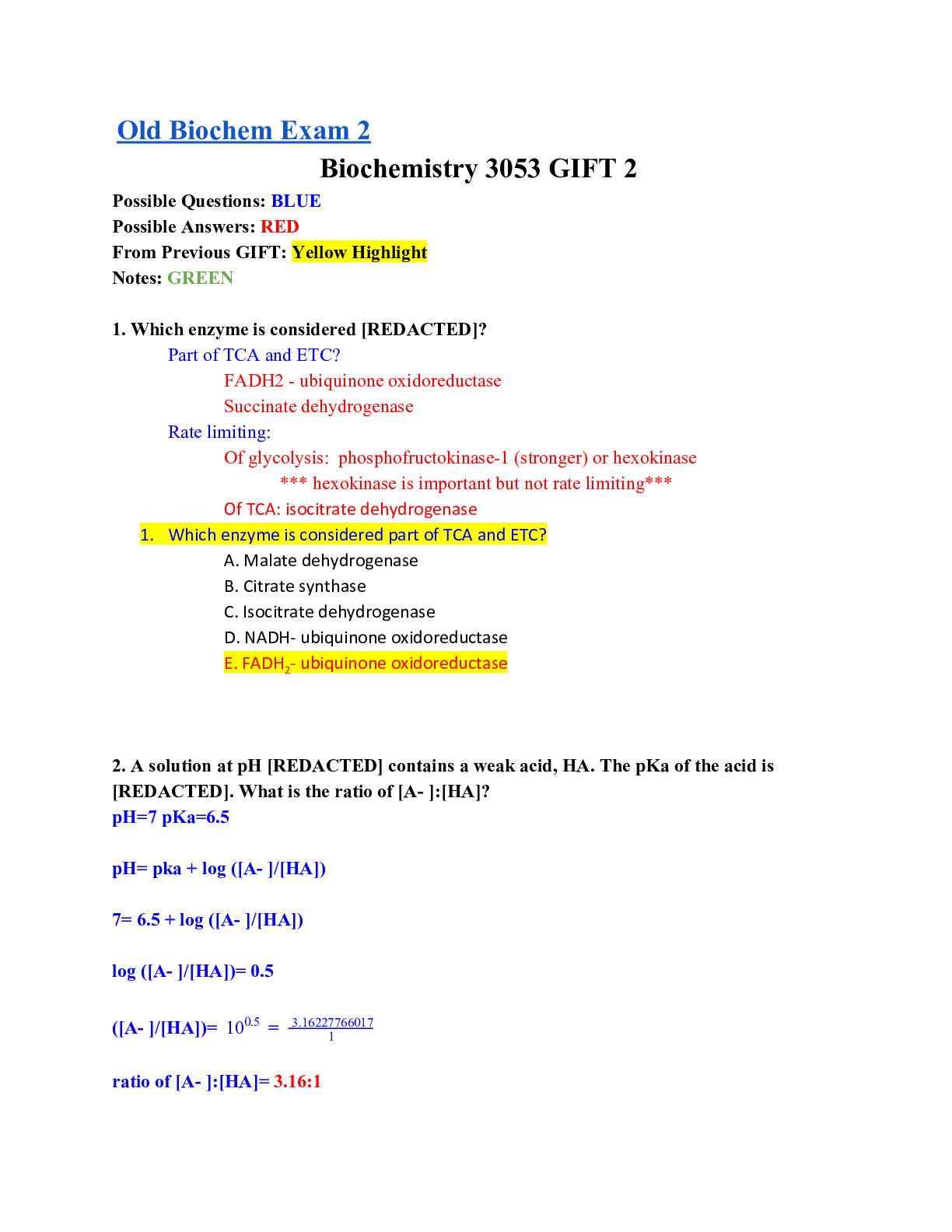
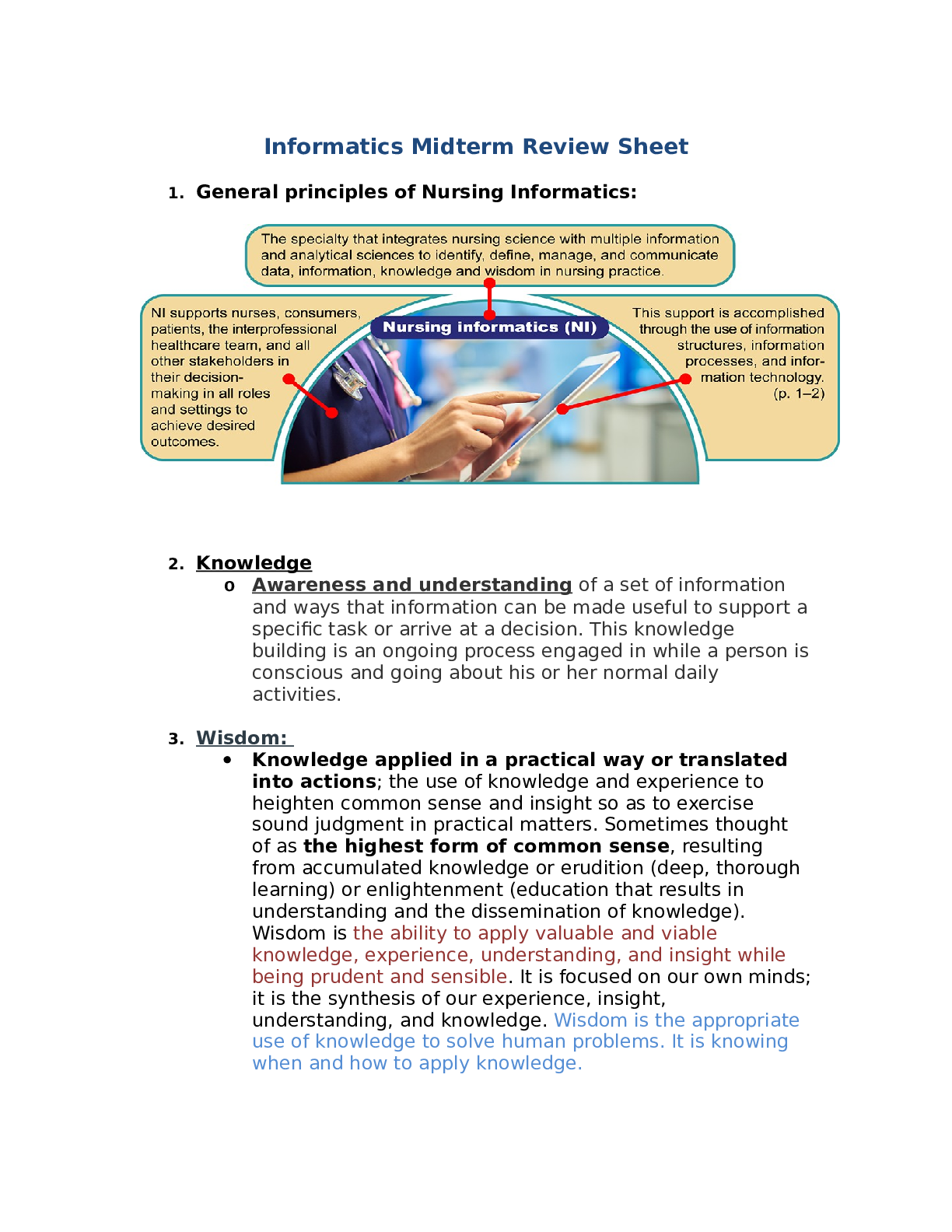
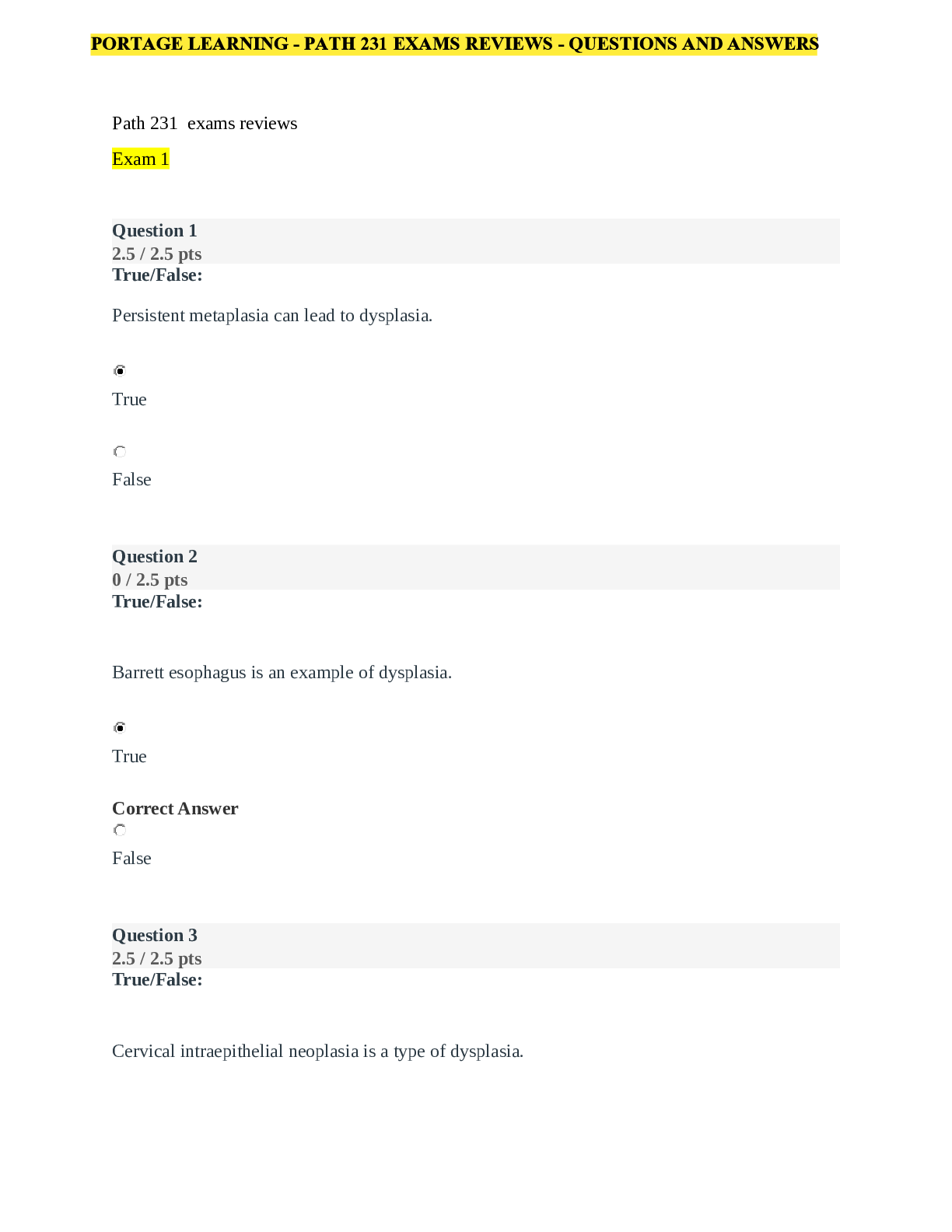

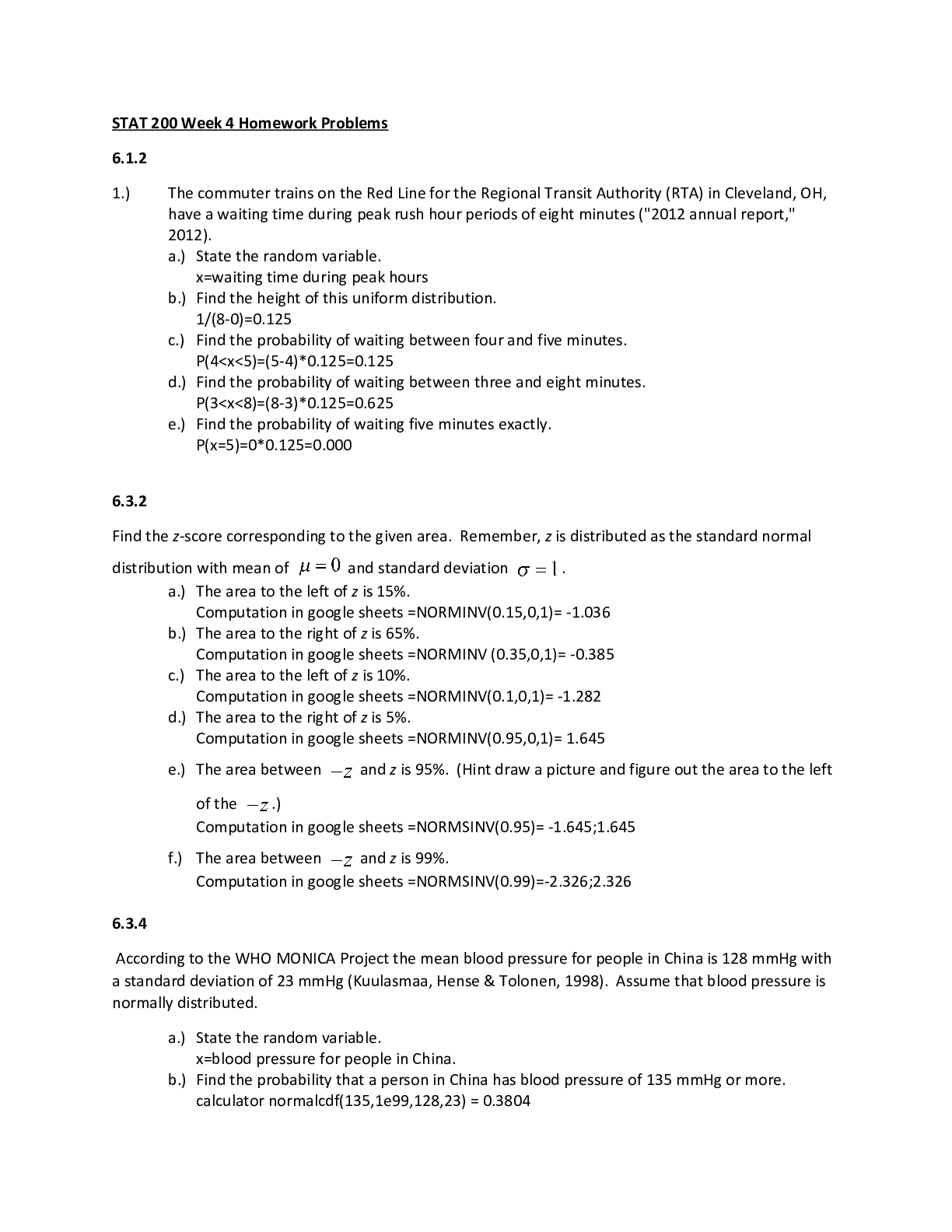
.png)

